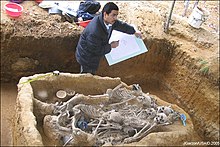Guatemalan genocide
1981–1983 genocide of Maya people in Guatemala / From Wikipedia, the free encyclopedia
Dear Wikiwand AI, let's keep it short by simply answering these key questions:
Can you list the top facts and stats about Guatemalan genocide?
Summarize this article for a 10 years old
The Guatemalan genocide, also referred to as the Maya genocide,[1] or the Silent Holocaust[3] (Spanish: Genocidio guatemalteco, Genocidio maya, or Holocausto silencioso), was the massacre of Maya civilians during the Guatemalan Civil War (1960–1996) by successive US-backed Guatemalan military governments.[4] Massacres, forced disappearances, torture and summary executions of guerrillas and especially civilian collaborators at the hands of security forces had been widespread since 1965, and was a longstanding policy of the military regime, which US officials were aware of.[5][6][7] A report from 1984 discussed "the murder of thousands by a military government that maintains its authority by terror".[8] Human Rights Watch has described "extraordinarily cruel" actions by the armed forces, mostly against unarmed civilians.[9]
| Guatemalan genocide | |
|---|---|
| Part of Guatemalan Civil War | |
 Excavation of the corpses of victims of the Guatemalan Civil War in Comalapa, Chimaltenango. | |
| Location | Guatemala |
| Date |
|
| Target | Maya peoples, alleged communists |
Attack type | Forced disappearance, genocidal massacre, torture, sexual violence, crimes against humanity |
| Deaths | 166,000 Maya[1] 200,000 total[2] |
| Perpetrators | Guatemalan government, local militias |
| Motive |
|
| Part of a series on |
| Genocide |
|---|
 |
| Issues |
| 18th /19th/early 20th century genocides |
| Late Ottoman genocides (1910s–1920s) |
| World War II (1939–1945) |
| Cold War (1940s–1991) |
| Contemporary ethno-religious genocides |
| Related topics |
|
| Category |
The repression reached genocidal levels in the predominantly indigenous northern provinces where the Guerrilla Army of the Poor operated. There, the Guatemalan military viewed the Maya as siding with the insurgency and began a campaign of mass killings and disappearances of Mayan peasants. While massacres of indigenous peasants had occurred earlier in the war, the systematic use of terror against them began around 1975 and peaked during the first half of the 1980s.[10] The military carried out 626 massacres against the Maya during the conflict[11] and acknowledged destroying 440 Mayan villages between 1981 and 1983. In some municipalities, at least one-third of the villages were evacuated or destroyed. A March 1985 study by the Juvenile Division of the Supreme Court estimated that over 200,000 children had lost at least one parent in the war, and that between 45,000 and 60,000 adult Guatemalans were killed between 1980 and 1985.[12] Children were often targets of mass killings by the army, including in the Río Negro massacres between 1980 and 1982.[13]
An estimated 200,000 Guatemalans were killed during the war, including at least 40,000 persons who "disappeared".[2] 92% of civilian executions were carried out by government forces.[2] The UN-sponsored Commission for Historical Clarification (CEH) documented 42,275 victims of human rights violations and acts of violence from 7,338 testimonies.[14][15] 83% of the victims were Maya and 17% Ladino.[16] In its final report in 1999, the CEH concluded that a genocide had taken place at the hands of the Armed Forces of Guatemala, and that US training of the officer corps in counterinsurgency techniques "had a significant bearing on human rights violations during the armed confrontation", but that the US was not directly responsible for any genocidal acts.[17][10][18][6][19] Former military dictator General Efrain Ríos Montt (1982–1983) was indicted for his role in the most intense stage of the genocide. He was convicted in 2013 of ordering the deaths of 1,771 people of the Ixil Indigenous group,[20] but that sentence was overturned, and his retrial was not completed by the time of his death in 2018.